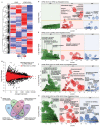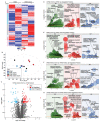Combined Alcohol Exposure and KRAS Mutation in Human Pancreatic Ductal Epithelial Cells Induces Proliferation and Alters Subtype Signatures Determined by Multi-Omics Analysis
- PMID: 35454872
- PMCID: PMC9027648
- DOI: 10.3390/cancers14081968
Combined Alcohol Exposure and KRAS Mutation in Human Pancreatic Ductal Epithelial Cells Induces Proliferation and Alters Subtype Signatures Determined by Multi-Omics Analysis
Abstract
Pancreatic Ductal adenocarcinoma (PDAC) is an aggressive cancer commonly exhibiting KRAS-activating mutations. Alcohol contributes to the risk of developing PDAC in humans, and murine models have shown alcohol consumption in the context of KRAS mutation in the pancreas promotes the development of PDAC. The molecular signatures in pancreas cells altered by alcohol exposure in the context of mutant KRAS could identify pathways related to the etiology of PDAC. In this study, we evaluated the combined effects of alcohol exposure and KRAS mutation status on the transcriptome and proteome of pancreatic HPNE cell models. These analyses identified alterations in transcription and translational processes in mutant KRAS cells exposed to alcohol. In addition, multi-omics analysis suggests an increase in the correlation between mRNA transcript and protein abundance in cells exposed to alcohol with an underlying KRAS mutation. Through differential co-expression, SERPINE1 was found to be influential for PDAC development in the context of mutant KRAS and ethanol. In terms of PDAC subtypes, alcohol conditioning of HPNE cells expressing mutant KRAS decreases the Inflammatory subtype signature and increases the Proliferative and Metabolic signatures, as we previously observed in patient samples. The alterations in molecular subtypes were associated with an increased sensitivity to chemotherapeutic agents gemcitabine, irinotecan, and oxaliplatin. These results provide a framework for distinguishing the molecular dysregulation associated with combined alcohol and mutant KRAS in a pancreatic cell line model.
Keywords: KRAS; Proteomics; SERPINE1; alcohol; pancreatic cancer.
Conflict of interest statement
The authors declare no conflict of interest.
Figures







References
-
- Moffitt R.A., Marayati R., Flate E.L., Volmar K.E., Loeza S.G., Hoadley K.A., Rashid N.U., Williams L.A., Eaton S.C., Chung A.H., et al. Virtual microdissection identifies distinct tumor- and stroma-specific subtypes of pancreatic ductal adenocarcinoma. Nat. Genet. 2015;47:1168–1178. doi: 10.1038/ng.3398. - DOI - PMC - PubMed
Grants and funding
LinkOut - more resources
Full Text Sources
Molecular Biology Databases
Research Materials
Miscellaneous

